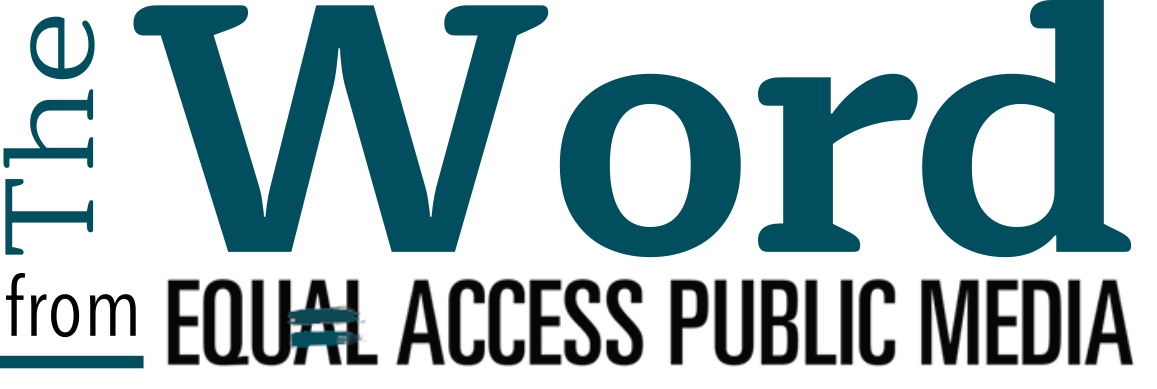Journalism moves unevenly to adopt accessibility practices
News sites continue to overlook accessibility, continuing to rank among the worst offenders of digital access
and EAPM staff
As journalism moves ever more online, digital accessibility lags behind for news outlets.
One reason for the persistent lack of accessibility in newsrooms is the continued invisibility of people with disabilities in public places and public discourse,
said Becca Monteleone, PhD, Associate Professor and Disability Studies Program Coordinator at the University of Toledo.
The World Health Organization reports more than 1.3 billion people around the world live with some kind of disability. That’s about a quarter of the population the news is potentially missing.
There seems to be a perception that disabled people are not consumers of news or members of the public — and so accessibility is often forgotten or treated as an afterthought,
Monteleone said. Disabled people have the same right to access information as the non-disabled public, and yet are consistently denied that right.
A digital division in the digital age
In 2025, WebAIM Million, an annual survey of website accessibility, reported that news sites again ranked among the worst for accessibility with an average of 59.8 errors per page. It was a slight improvement from 2024, when the survey found 69.5 errors per page., but still a noticeable flaw.
Out of all problems news sites were evaluated for, low contrast and missing alt text remained the top two problems found. (https://webaim.org/projects/million/2024).
Large news outlets including BBC, Al Jazeera, and The New York Times have made accessibility commitments, and innovations have been tested by outlets such as Newslaundry in India. Despite that, there is a large range of inconsistency in their application across platforms and geographies.
Newsrooms are looking first at tight budgets when considering what to add, including accessibility measures.
News outlets are hanging by a thread,
said Stacy Kess, founder and chief of editor of Equal Access Public Media (EAPM), an organization dedicated to making journalism more accessible. There’s no funding behind many of them. To have a person dedicated to making sure everything is accessible is not something most news outlets can or want to dedicate their resources.
EAPM publishes The Word.
However, accessibility experts say that many accessibility practices are inexpensive or even free. Alt text, image descriptions and video description, compatibility with screen readers, and contrast-compliant designs are a matter of awareness.
It starts with who is in the newsroom and if those people are listened to, said Johny Cassidy, BBC Digital Specialy Projects Producer and accessibility expert.
Once we employ diversity of thought in our newsrooms, we have to listen. We have to lean into what that diversity is actually telling us and act accordingly,
Cassidy said. If we have Deaf or blind colleagues, find out what accessible content looks like for them.
In the U.S., no organization specifically tracks disability in journalism, despite an estimated 28.7 percent of the adult population identifying as disabled. In Jan. 2025, EAPM released a white paper with analysis of data from the U.S. Bureau of Labor Statistics to calculate how many journalists are disabled. The result was staggering: only 7.8 percent of working journalists in the U.S. have a disability.
In the U.K., on the other hand, the National Council for the Training of Journalists estimates about 22 percent of journalists identify as disabled — much closer to both the U.K. and world population estimate of about 1 in 4 adults identifying as disabled.
People with disabilities are not just consumers of news, but producers of news,
Monteleone said. Inclusion and accessibility strategies cannot be confined to the delivery of news products. We need to also consider how disability is being written about in journalism, pathways for disabled journalists to enter and stay in the field, and supporting disabled sources. Historically, coverage of disability in the news media has been poor and rooted in ableist stereotypes—the only way to address that is to invite in disabled perspectives at all levels.
The educational gap
Accessibility is rarely a part of journalistic education or the editorial process. Journalists learn to package a narrative, confirm a fact, or maximize a headline but not to write alt text, describe images, or caption videos.
When I speak at conferences, I can see the
Kess said. aha-moment
for a lot of people,I can see that I am introducing new information when I talk about making newsrooms more accessible to journalists with disabilities or news content more accessible to news audiences with disabilities. You don’t know what you don’t know.
Some universities now offer inclusive design courses or courses on disability in the media — not just to teach compliance but to create empathy and to help journalists understand their audience at every level of ability. But progress remains uneven.
We teach journalists how to report facts, how to interview, how to do write a news article, and so on, but we don’t teach them about accessibility,
Kess said. And with most journalism online, we don’t teach them about WCAG. We don’t teach them HTML mark-up that fits WCAG guidelines. We don’t teach them about what screen reader software can and cannot read. We don’t teach them any of that.
Even if journalism schools taught accessibility and newsrooms hired enough disabled reporters to bring those voices to the table, some problems remain.
The most influential medium of news in most of the world — television news — is still mostly unreachable to deaf and hard of hearing people. Sign language interpretation is an exception and not a norm, even in public service broadcasters.
There simply aren’t enough sign language interpreters anywhere,
Kess said. The shortage is global — and that leaves television news literally silent for millions.
In the U.S., for up to 1 million people whose primary language is American Sign language, there are only 10,000 certified ASL interpreters. That’s 1 interpreter for every 100 people who sign ASL.
Cassidy underlined this point with urgency.
If journalism isn’t serving everyone, then it’s failed in its duty,
Cassidy said. Ensure tools and platforms as well as policies and processes are actually removing barriers which allow all of us to thrive.
The shifting tide
The trend toward accessibility is slowly shifting. Accessibility workshops, newsroom audits, and advocacy networks are gaining ground. International bodies like the International Association of Accessibility Professionals (IAAP), EAPM, and the European Broadcasting Union have initiated programs to promote accessible journalism practices.
Cassidy also noted the looming challenge and opportunity of technology.
One of the biggest developments in journalism will undoubtedly be AI,
Cassidy said. For it to benefit everyone though, we need to ensure any and all platforms using AI technology aren’t exacerbating and compounding existing biases. We need to make sure all user interfaces work seamlessly and securely with assistive technology. Every single part of the AI and wider newsroom journey needs to be as friction-less as possible.
Many news organizations are leaning into accessibility and creating access solutions for audiences who don’t access content in what might be considered the traditional way,
Cassidy said.
The BBC has experimented with new tools and new ideas, including BBC Ability, a staff-led network by disabled employees for a disabled audience with accessibility in mind. This includes Able Magazine.
There’s been a definite growth in the awareness of the opportunities creating accessible content can bring, and this is only going to increase as we keep pushing for greater diversity across our newsrooms,
he said. Too many newsrooms have historically fished from a narrow pool which means those on the margins haven’t been catered for.
Ishraq Ahmed Hashmi is a freelance journalist and commentator who concentrates on accessibility, media ethics and social justice. His work discusses the way in which inclusive practices can transform journalism and open up the engagement of people. Follow him on LinkedIn at /in/Ishraq-Ahmed-Hashmi.
This is news. This article uses interviews with experts and people whose experiences are relevant to a topic along with facts to tell a story about an issue.
Want more of the Word?
Become a Word Patron
Love what you’re reading? Want a to read more? Become a Patron and support The Word for as little as $2.99 a month.

